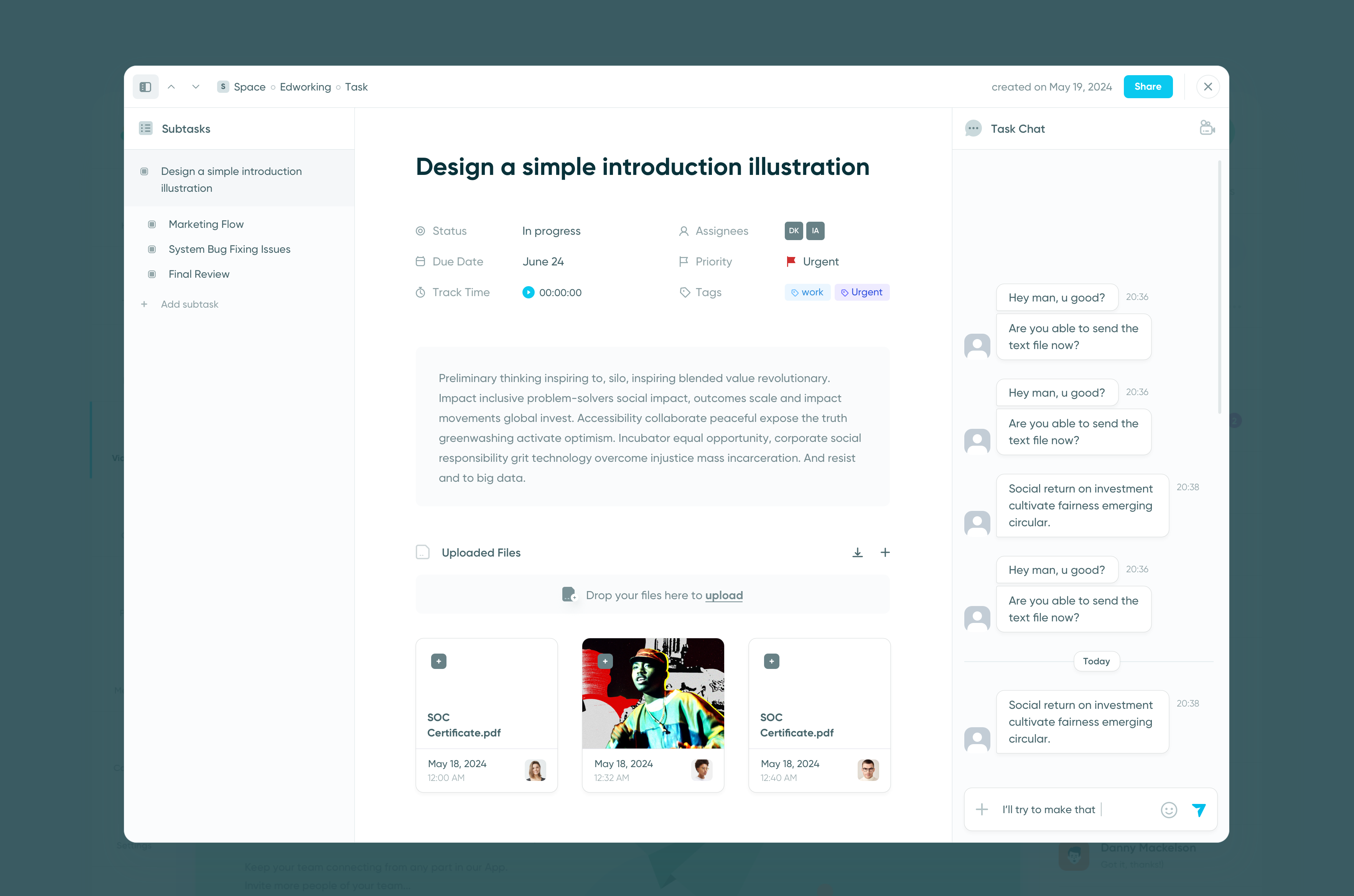Have you ever felt like your day disappeared in a flurry of half-finished tasks, unanswered emails, and scattered thoughts? You're not alone. Research shows that context switching—the act of jumping between different tasks—can cost individuals up to 40% of their productive time (American Psychological Association). Imagine what your team could achieve with almost half a workday reclaimed!
At its core, context switching occurs when we shift focus from one task to another, forcing our brains to constantly "reset" and refocus. While it might seem harmless or even inevitable in fast-paced environments, this process takes a toll on both mental clarity and work efficiency. For teams, the consequences can be even more pronounced, affecting deadlines, creativity, and overall morale.
In today’s hyper-connected world, understanding the impact of context switching is no longer optional—it's essential. In this article, we’ll dive into the hidden costs of context switching, explore its effects on team focus and output, and share actionable strategies to help your team minimize its impact. Let’s get started!
 What is Context Switching?
What is Context Switching?

At its simplest, context switching is the act of shifting your attention from one task to another. Think of it like juggling—you’re constantly throwing one ball into the air while trying to catch another. Each time you switch tasks, your brain has to pause, reorient, and focus on the new activity. This may feel quick and seamless, but under the surface, it’s much more complicated.
The Science Behind It
Our brains are designed to focus deeply on one task at a time. When we multitask or shift between unrelated activities, we force our mental processes to restart and recalibrate. This is called a cognitive switching penalty, and it takes time and energy. Studies suggest that switching between tasks can delay productivity by up to 25%, as your brain needs time to "warm up" for the new activity.
Imagine driving a car. Switching gears requires a moment of coordination—you can’t simply jump from first to fifth without grinding to a halt. Similarly, when your brain switches gears between tasks, it slows down momentarily to adjust, which over time adds up to significant productivity loss.
Why It Impacts Focus
When we rapidly alternate between tasks, our working memory—the part of our brain responsible for holding and processing immediate information—gets overwhelmed. This overload not only hampers focus but also increases the likelihood of forgetting important details, making mistakes, or feeling mentally drained.
In a world where notifications ping constantly and demands pile up, context switching feels unavoidable. But understanding how it works is the first step to regaining control and maintaining focus.
 The Cost of Context Switching
The Cost of Context Switching
Time Costs

Context switching is a silent productivity killer, stealing precious hours from our workday without us realizing it. Studies have shown that it takes an average of 23 minutes and 15 seconds to refocus on a task after being interrupted. Imagine switching between tasks multiple times in a day—that’s hours of lost productivity.
For example, if a team member is managing emails, attending meetings, and working on a report all in one morning, the frequent switches could cut their effective working time by almost half. When this pattern repeats across an entire team, the collective time loss becomes staggering.
Cognitive Overload
The brain isn't designed to multitask effectively; it thrives on deep focus. Constantly switching between tasks leads to cognitive overload, where your mental resources are stretched too thin. This can:
- Reduce the ability to make informed decisions.
- Stifle creativity, as the brain lacks the time and space needed for innovative thinking.
- Increase errors, since divided attention leads to oversight.
Think of it like opening too many apps on your smartphone. Eventually, the device slows down, crashes, or freezes. Similarly, our brains "lag" when asked to juggle multiple tasks simultaneously, leading to exhaustion and frustration.
Team-Wide Effects
On a team level, the effects of context switching ripple across projects and timelines. Consider this hypothetical scenario:
- Task juggling: A project manager spends their morning answering urgent Slack messages, preparing a presentation, and reviewing a teammate’s work. Each task requires a different set of mental tools, and switching between them slows overall progress.
- Communication breakdowns: While multitasking, the project manager misses key details in emails, leading to confusion about deadlines.
- Delayed projects: As individual tasks lag, collaborative efforts fall behind schedule, causing friction among team members.
This domino effect can harm team morale and lead to burnout as everyone struggles to keep up. The end result? Missed deadlines, subpar deliverables, and a stressed-out team.
When teams fail to address the cost of context switching, it doesn’t just affect output—it affects trust, efficiency, and workplace satisfaction. Recognizing these hidden costs is the first step toward building a more focused and productive work environment.
 How Context Switching Impacts Team Focus
How Context Switching Impacts Team Focus
Reduced Engagement
Ever tried to dive into a task, only to be interrupted by a flurry of notifications or an unexpected meeting? This constant shifting can sap your interest in the task at hand. For teams, this effect is even more pronounced. When members are forced to juggle competing priorities—emails, project updates, and brainstorming sessions—they struggle to achieve the deep focus necessary for meaningful work.
Lack of engagement often stems from the inability to see tasks through to completion. When team members feel they’re always leaving things half-done, they lose a sense of accomplishment. Over time, this fragmented work style diminishes motivation, leaving teams feeling unfulfilled and disengaged.
Errors and Oversights
Context switching isn’t just a productivity drain—it’s also a recipe for mistakes. Every time a team member shifts between tasks, they risk forgetting critical details or misinterpreting instructions. For instance, an engineer toggling between writing code and answering support tickets might overlook a small bug that later escalates into a major issue.
Even minor oversights can snowball in collaborative settings, where one error leads to a cascade of problems for the entire team. This constant pressure to multitask heightens the likelihood of mistakes, reducing the overall quality of output and creating friction among teammates.
Burnout Risks
The relentless pace of modern work environments can leave teams running on empty. Constantly switching between tasks doesn’t just drain focus—it also takes a toll on mental and emotional well-being. The cognitive load from multitasking often leaves team members feeling overwhelmed and fatigued, even if they haven’t completed much by the end of the day.
Over time, this stress can lead to burnout. Symptoms like irritability, exhaustion, and reduced productivity creep in, affecting both individual performance and team dynamics. A burned-out team isn’t just less effective—it’s also less creative, collaborative, and resilient in the face of challenges.
By addressing the root causes of context switching, organizations can foster a healthier, more engaged workforce that’s better equipped to meet its goals without sacrificing well-being.

 How Context Switching Affects Output
How Context Switching Affects Output

Quality Degradation
When attention is fragmented, the quality of work suffers. Each time you switch tasks, your brain loses focus, which increases the likelihood of mistakes. For example, writing a detailed report while responding to Slack messages can result in incomplete thoughts, grammatical errors, or overlooking critical data.
This drop in quality isn’t just about small errors—it impacts the overall polish of deliverables. A marketing team juggling multiple campaigns, for instance, might miss subtle but crucial details in ad copy or design. The final product may lack the refinement that comes from deep focus and thorough review.
Missed Deadlines
Context switching often causes delays that ripple across interconnected tasks, creating a cascade of missed deadlines. When one task takes longer than planned due to frequent interruptions, it delays subsequent tasks, creating a domino effect.
Take this scenario: A designer tasked with creating visuals for a product launch gets interrupted to troubleshoot a client’s urgent issue. By the time they return to the original task, they’ve lost valuable time—and the project deadline moves further away. For teams with interdependent workflows, these delays snowball, impacting everyone involved and leading to last-minute scrambles or incomplete projects.
Stifled Innovation
Creativity and innovation require uninterrupted periods of focus. Deep work allows the brain to explore ideas, make connections, and develop novel solutions. However, context switching disrupts this process, leaving no room for the sustained concentration needed to think outside the box.
Imagine an engineering team working on a groundbreaking feature. If developers constantly switch between debugging old code, attending meetings, and brainstorming new solutions, the innovation process is stunted. They lack the mental bandwidth to engage deeply with the problem, resulting in incremental progress rather than transformative breakthroughs.
In a fast-paced work environment, the true cost of context switching isn’t just lost time—it’s the missed opportunity to deliver high-quality work, meet critical deadlines, and achieve creative excellence. To combat these effects, teams must prioritize focus and implement strategies that minimize unnecessary task shifts.
 Practical Tips to Minimize Context Switching
Practical Tips to Minimize Context Switching
Set Clear Priorities: The Power of Single-Tasking
The first step to reducing context switching is embracing single-tasking—focusing on one task at a time. Clear priorities eliminate the mental chaos of juggling too many responsibilities.
Start by defining the most important tasks for the day, week, or project. Use frameworks like the Eisenhower Matrix to categorize tasks by urgency and importance. By concentrating on high-priority items, you allow your brain to fully engage and complete tasks faster and more effectively.
Batch Similar Tasks: Grouping Activities to Maintain Momentum
Imagine checking emails, making phone calls, and updating spreadsheets all at once—it’s a recipe for disaster. Instead, try batching similar tasks. Grouping related activities reduces the cognitive effort required to switch between them, helping you stay in the zone.
For example:
- Dedicate specific time blocks for communication tasks like responding to emails or attending meetings.
- Reserve another block for focused work, such as writing reports or coding.
- Use "themed days" for ongoing projects to focus on particular types of work without distraction.
This approach streamlines your workflow and allows you to tackle similar tasks with uninterrupted focus, boosting efficiency.
Use Tools to Reduce Noise
In today’s digital workplace, tools can either be your worst enemy or your best friend. To combat context switching, choose tools that help reduce noise and distractions:
- Task Managers: Platforms like Asana or Trello let you organize, assign, and track tasks without confusion.
- Notification Settings: Turn off non-essential notifications during deep work sessions. Use "Do Not Disturb" or notification scheduling to minimize interruptions.
- Automation: Automate repetitive tasks wherever possible. For example, email filters can sort incoming messages, and tools like Zapier can connect apps to handle routine workflows.
These tools create a calmer, more focused environment, enabling you to give undivided attention to your work.
Establish Team Norms: Encourage Deep Work Zones and Asynchronous Communication
Context switching isn’t just an individual problem—it’s a team issue. Teams can work together to reduce interruptions by setting clear norms around communication and collaboration.
- Deep Work Zones: Designate specific times for uninterrupted work, where team members agree not to disturb each other unless there’s an emergency.
- Asynchronous Communication: Encourage communication methods that don’t require immediate responses, like email or shared documents, rather than relying solely on instant messaging.
- Clear Expectations: Establish when and how team members should respond to messages or attend meetings. This prevents unnecessary back-and-forth and protects focused work time.
By implementing these strategies, teams can create a work culture that values focus, minimizes distractions, and maximizes output. The key is consistency—these habits take time to develop but lead to lasting improvements in productivity and morale.
 Context Switching in Action
Context Switching in Action

Meet Team Velocity, a small software development team tasked with launching a new app feature under a tight deadline. The team had a mix of roles: developers, a designer, a project manager, and a QA specialist. On paper, they were well-equipped to succeed. But in practice, they were stuck in a cycle of delays and missteps—and context switching was the culprit.
The Problem
Team members were constantly pulled in different directions. Developers would be halfway through debugging code when the project manager called for an impromptu meeting. The designer frequently paused work on the interface to provide urgent asset updates for marketing. The QA specialist, meanwhile, was toggling between testing the new feature and documenting bugs in a different project.
The result?
- Missed deadlines: Every interruption added up, pushing their timeline further out.
- Frustration: Team members grew resentful of interruptions, leading to tension.
- Quality issues: The rushed, fragmented work led to bugs that delayed releases further.

The Solution
Recognizing the impact of context switching, the project manager decided to overhaul their workflow. Here’s how they did it:
- Adopted Time Blocking:
They implemented a team-wide time-blocking system. Mornings were reserved for deep work, with no meetings or non-urgent communications allowed. Afternoons were for collaborative tasks like meetings and code reviews. - Centralized Communication:
They moved all communications to a project management tool where priorities were clearly outlined. Urgent updates were tagged and addressed during designated time blocks. - Task Ownership:
Each team member was assigned specific responsibilities with minimal overlap, reducing the need for constant clarifications and handoffs. - Encouraged Asynchronous Work:
Instead of interrupting developers with real-time requests, the project manager encouraged teammates to log requests in a shared document or through task management software.
The Outcome
Within a month, Team Velocity’s productivity improved significantly. They delivered the new app feature on time and with fewer bugs than anticipated. Team morale also improved as members felt more in control of their workdays and less overwhelmed by constant interruptions.
This example highlights the tangible benefits of tackling context switching head-on. By adopting structured workflows and prioritizing focus, teams can reclaim lost time, improve collaboration, and achieve their goals with less stress.
 How Edworking Helps Teams Avoid Context Switching
How Edworking Helps Teams Avoid Context Switching
In the quest to minimize context switching, Edworking emerges as a comprehensive solution, integrating essential tools into a unified platform. This design fosters seamless collaboration and sustained focus, effectively reducing the disruptions caused by juggling multiple applications.
Streamlined Workflows
Edworking consolidates project management, communication, and file sharing into one cohesive environment. Teams can manage tasks with features like tags, estimations, and board views, ensuring clarity and organization. This integration eliminates the need to switch between disparate tools, allowing team members to maintain their focus and work more efficiently.

AI Tools for Focus
At the heart of Edworking's platform is the Edworking Brain, an AI-powered assistant that unifies knowledge, tasks, documents, images, and files. By providing intelligent solutions to streamline workflows and improve productivity, Edworking Brain helps teams stay on track and minimizes the mental load associated with managing multiple tasks.
Collaboration Without Disruption
Edworking's integrated communication tools, including video calls and chat, are seamlessly woven into the workspace. This design fosters real-time dialogue and creativity without requiring users to leave their current tasks. By housing all collaborative efforts within dedicated workspaces, Edworking ensures that transitions between tasks are smooth and non-disruptive, preserving team focus and cohesion.
By leveraging Edworking's integrated features and AI capabilities, teams can significantly reduce the detrimental effects of context switching, leading to enhanced productivity and a more harmonious workflow.
 Conclusion
Conclusion
Context switching may seem like a minor inconvenience in the moment, but its long-term effects on productivity, focus, and morale are anything but small. We've explored how frequent task-shifting steals valuable time, overloads our cognitive capacity, and diminishes the quality of work. For teams, the ripple effects can lead to delays, increased errors, and even burnout.
Addressing this challenge isn’t just about improving work output—it’s about fostering a healthier, more focused, and more engaged team environment. By adopting practical strategies like prioritization, task batching, and time-blocking, and by leveraging tools that centralize workflows, teams can regain control and perform at their best.
The good news? You don’t have to tackle this problem alone. Tools like Edworking provide the structure and support needed to minimize distractions and keep teams aligned. With features designed to streamline workflows and promote focus, Edworking is a game-changer for organizations ready to break free from the cycle of context switching.
So, what are you waiting for? Take the first step toward reclaiming your team's productivity and creativity. Start implementing these strategies today, and explore how Edworking can revolutionize the way you work!





